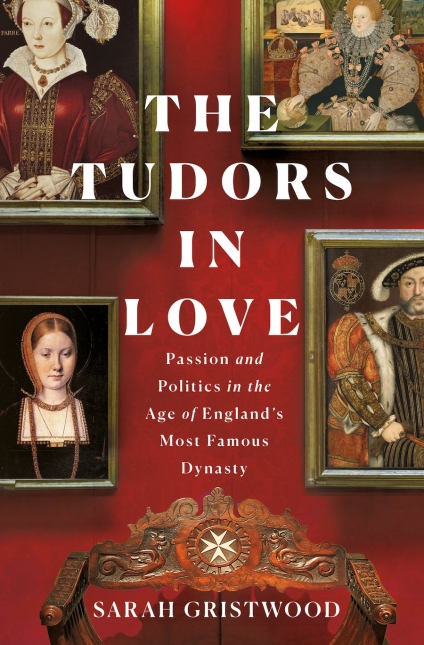The Tudors in Love: Passion and Politics in the Age of England’s Most Famous Dynasty
- By Sarah Gristwood
- St. Martin’s Press
- 400 pp.
- Reviewed by Bob Duffy
- February 9, 2023
An intelligent, astute account of those randy royals.

The marvelous social history The Tudors in Love is the latest from Sarah Gristwood, British chronicler of (mostly) queenly rulership. (Readers may recall the Independent’s 2017 review of her Game of Queens: The Women Who Made Sixteenth Century Europe.) Here, Gristwood directs her gaze at the romantic — and correspondingly dynastic — goings-on at the 16th-century English royal court, giving us solidly grounded scholarship presented with erudition, eloquence, and insight.
Her survey begins with the marital misadventures of the young Henry VIII. She wraps it up neatly, 90-some years later, with the death of his daughter Elizabeth I, the self-touted “Virgin Queen” who squeezed more mileage out of her virtuous public brand than Doris Day (and possibly with more duplicitous intent).
Gristwood also covers a handful of near relations to the throne — royals in their own right — including Henry’s sisters Mary (briefly queen of France) and Margaret (queen of Scotland), as well as Elizabeth’s cousin Mary, Queen of Scots. She combs through royal records, letters both personal and diplomatic, the testimony of near-contemporaries, and the work of modern scholars.
What results is compelling history and brilliant analysis centering on the stagey, ritualized interactions between men and women at court. Gristwood has an ear for both the high-toned and the mundane (international diplomacy vs. interpersonal romantic posturing). Tellingly, she probes the message behind the Tudors’ theatrical pageantry and tiltyard competitions, most notably in Henry’s reign.
This impulse to entertain the court in productions tricked out with allegorical iconography is the stalking horse in Gristwood’s analysis. Take this vignette depicting a tournament early in Henry’s reign:
“The festivities had a theme to them, and that theme was the heart…the symbol was everywhere.
“[One pair of knights] jousted in white velvet embroidered with a heart divided in two by a chain. Written on the borders was the motto: ‘My heart is between joy and pain.’ [Two others] wore crimson satin with a heart confined in blue lace, and written in gold: ‘My heart is bound’…
“The courser the king rode on was decked in cloth of silver…embroidered with letters of gold. His device was ‘a heart of a man wounded’ and his motto declared ‘Elle mon coeur a navera’ — she hath wounded my heart. It was the old passion of uplifting pain, the lover elevated by his adoration of a lady who held him at bay, which had gripped the imaginations of aristocratic Europe for centuries.”
There’s the nutshell, the framework on which Gristwood skillfully hangs her tale. It hinges on a social and literary convention that permeated Tudor behavior — the pan-European mashup of pose and practice that’s come to be known as courtly love — for most of the dynasty’s run. With roots in matriarchal myth and folklore — and revving up with the 12th-century “cult” of the Virgin Mary — the tradition centered on the ideal devotion of a nobleman (or poet) for his lady.
As Henry’s tourney signals, the courtly trope shackled the male admirer, adrift in a befuddling froth of love and loyalty, to an assumed posture of utter subjection to an often emotionally distant woman. This devotion was ideally chaste, but in practice (face the facts, reader), it was naturally subject to slippage into the fleshly — and not just in real life but inevitably in life’s hall-of-mirrors elaborations in literary romance. (Consider the thousand and one variants on the Arthur/Guinevere/Launcelot triangle, which Gristwood explores in captivating style.)
The author traces this allegorical trail through the reigns of the four Tudor monarchs, concentrating on those of Henry and Elizabeth. She counterpoints the posturing ceremonials and royal-love propaganda with the dalliances, documented or rumored, that they apparently inspired or masked. In Henry’s case particularly, the evidentiary traces run rampant, with the king rumbling through sexual entanglements (and at least three of his six marriages) while mouthing the platitudes of female primacy. He probably believed them, at least in part, as his importuning letters to Anne Boleyn testify, until, the winds shifting, he abruptly dropped the pretense — with fatal results for Anne, and later, for Queen Katherine Howard, too.
And that’s the bitter, real-world falsehood behind the Tudor love game. Elizabeth played the B-side of the game, turning the parallel pretense of the distantly desirable woman to diplomatic advantage as noble suitors from the Continent circled eagerly, eyes on the royal prize. This, of course, is the core of the “Virgin Queen” brand, but Gristwood suggests, citing contemporary rumors, that the pose could have also cloaked a grand imposture, with at least a few of Elizabeth’s summer sojourns in the countryside serving as royal maternity leave. Tabloid stuff this, and enticing to boot. But Gristwood leaves it at that.
The Tudors in Love is history at its best, a novel exploration on an otherwise well-traveled path. Read it for Gristwood’s marvelous insight into the intersection of Tudor amatory imagination and the realities of royal power, or read it for its sprightly storytelling. For the scholar or the informed reader, it’s richly rewarding in either case.
Bob Duffy is an erstwhile scholar of Tudor times who’s authored articles on Shakespeare, Thomas More, and the theatrical pageantry of King Henry’s court. For better or worse, he can’t seem to shake the bug.

